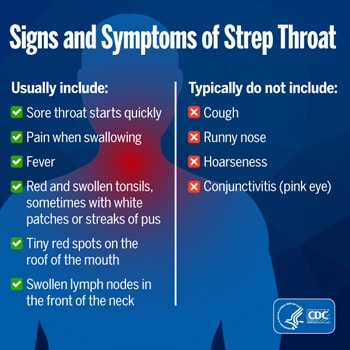Bacteria cause strep throat
Viruses are the most common cause of a sore throat. However, strep throat is an infection in the throat and tonsils caused by bacteria called group A Streptococcus (group A strep).
How you get strep throat
Group A strep live in the nose and throat and can easily spread to other people. People who are infected spread the bacteria by talking, coughing, or sneezing, which creates small respiratory droplets that contain the bacteria. They can also spread the bacteria from infected sores on their skin.
It usually takes two to five days for someone exposed to group A strep to become ill with strep throat.
It is important to know that some infected people do not have symptoms or seem sick. People sick with strep throat are much more contagious than those who do not have symptoms.
People can get sick if they:
- Breathe in respiratory droplets that contain the bacteria
- Touch something with those droplets on it and then touch their mouth or nose
- Drink from the same glass or eat from the same plate as a person infected with group A strep
- Touch sores on the skin caused by group A strep (impetigo) or come into contact with fluid from the sores
Rarely, people can spread group A strep through food that is not handled properly (visit CDC’s food safety page).
Pain and fever without a cough are common signs and symptoms
In general, strep throat is a mild infection, but it can be very painful. The most common symptoms of strep throat include:
- Sore throat that can start very quickly
- Pain when swallowing
- Fever
- Red and swollen tonsils, sometimes with white patches or streaks of pus
- Tiny, red spots (petechiae — pronounced pi-TEE-kee-eye) on the roof of the mouth (the soft or hard palate)
- Swollen lymph nodes in the front of the neck
Other symptoms may include a headache, stomach pain, nausea, or vomiting — especially in children. Someone with strep throat may also have a rash; when this happens it is known as scarlet fever (scarlatina).
The following symptoms suggest a virus is the cause of the illness instead of strep throat:
- Cough
- Runny nose
- Hoarseness (changes in your voice that make it sound breathy, raspy, or strained)
- Conjunctivitis (pink eye)

Children and certain adults are at increased risk
Anyone can get strep throat, but there are some factors that can increase the risk of getting this common infection.
Strep throat is more common in children than adults. It is most common in children 5 through 15 years old. It is very rare in children younger than 3 years old.
Adults who are at increased risk for strep throat include:
- Parents of school-aged children
- Adults who are often in contact with children
Close contact with another person with strep throat is the most common risk factor for illness. For example, if someone has strep throat, the bacteria often spread to other people in their household.
Infectious illnesses tend to spread wherever large groups of people gather. Crowded settings can increase the risk of getting a group A strep infection. These settings include:
- Schools
- Daycare centers
- Military training facilities
- Up to 3 in 10 children with a sore throat have strep throat
- About 1 in 10 adults with a sore throat has strep throat
A simple test gives fast results
A doctor will determine what type of illness you have by asking about symptoms and doing a physical exam. If they think you might have strep throat, they will swab your throat to test for strep throat.
There are two types of tests for strep throat: a rapid strep test and throat culture.
A rapid strep test involves swabbing the throat and running a test on the swab. The test quickly shows if group A strep is causing the illness.
If the test is positive, doctors can prescribe antibiotics. If the test is negative, but a doctor still suspects strep throat, then the doctor can take a throat culture swab.
A throat culture takes time to see if group A strep bacteria grow from the swab. While it takes more time, a throat culture sometimes finds infections that the rapid strep test misses.
Culture is important to use in children and teens since they can get rheumatic fever from an untreated strep throat infection.
For adults, it is usually not necessary to do a throat culture following a negative rapid strep test. Adults are generally not at risk of getting rheumatic fever following a strep throat infection.